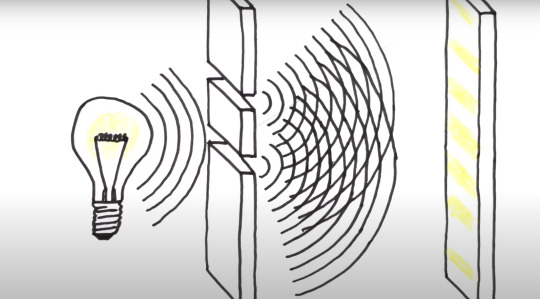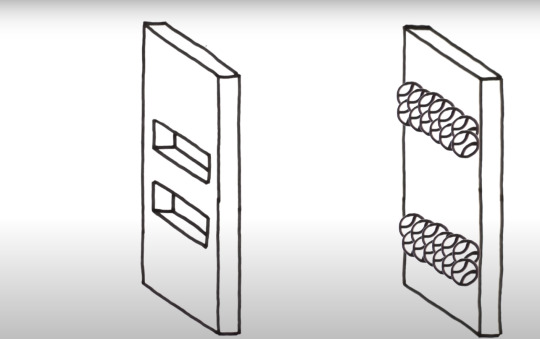Text
Ramble about crazy physics, part one
So, once again. The double-slit experiment. Although, actually the many worlds interpretation, but I need both the double slit experiment and Schrödinger's famous cat to explain the whole thing. You may already know these experiments, but I'll explain them anyway, just in case you don't. Also I'll probably split this ramble up in multiple posts, just so that one doesn't become to long.
Let's start with the double slit experiment, one of my favorites. It consists of an aperture with two parallel slits and a collecting screen. Small particles of material or a beam of light are sent through the two slits in order to obtain a so-called interference pattern at the collecting screen. In the case of waves (light), an interference pattern is obtained that is somewhat irregular and looks like this:

This pattern is created because the wave splits at the slits and the newly created waves influence each other. With particles (small material) you get an interference pattern that traces the two slits quite precisely and looks like this (shown as tennis balls, but it's the same principle):

So far, so good.
Now we carry out this experiment with electrons, first with only one slit. We know that an electron is a particle, and that's exactly what the interference pattern we get looks like. So let's try it with two slits. What kind of interference pattern do we get? That's right. The interference pattern of a wave- Wait, what? But that's exactly how it is. We get an interference pattern that looks pretty much like a wave. Okay, maybe we did the experiment too fast and the electrons repelled each other. So we carry out the experiment more slowly, over hours, particle by particle. But the result is the same. We get the interference pattern of a wave. What is particularly confusing is that some places where the electron is on the collecting screen cannot be reached by a direct path through the slit, while other places that could be reached by a direct path remain free. Now we want to find out why this is the case. To do this, we attach a particle counter to the aperture to see which slit the individual electron flies through. And obtain the interference pattern of a particle. It almost seems as if the electron doesn't want us to understand it. Well, thanks, but we humans are not as stupid as we seem. We switch off the particle counter, but leave it in place. We'll see who's tricking who here - - and we get the interference pattern of a wave again. Well. Too bad.
How can it be that the interference pattern changes as soon as we try to fathom it? Scientists are still unable to answer this question, but there is a well-known theory on the subject that is held by many scientists.
The Koppenhagen interpretation. This states that the electron is in a so-called superposition until it is forced to make a decision by observation. This means that the electron is on all possible paths until it is observed. And if you plot all possible paths, what do you get? Exactly. A wave. *Brain explosion.* (Weeeeeeeeeeeeee... Bam Kabush Crash Boom Whoosh) So, like a wave, when the electron hits the two slits, the possible paths (my brain is dying right now) interfere with each other, creating an interference pattern piece by piece as soon as they are forced by the collecting screen to choose a possible path. But why does this change as soon as we attach a particle counter? Well. When the electron hits the particle counter, we already force the electron to choose a slit at this point to fly through either the upper or the lower slit. This means that if the electron decides to go through the upper slit, for example, the only possible paths left are the ones of the upper slit, which can no longer interfere with the possible lower paths → no wave interference pattern.
And this experiment is no joke so ingenious and mind-blowing that I can't even put it into words. How do you come up with something like this? How can it be that our observation can influence the result of an experiment, a reaction or ANYTHING in general? It may seem small now, but it just seems as if the world doesn't want us to understand it. Or at least the part of the world that includes quantum mechanics. How many times has it happened that our observation has influenced a result without us realizing it? How can we carry out experiments at all if our observation falsifies the result? Is this perhaps the reason why so many things should actually work in theory, but in practice it works quite differently? I don't believe that the electron is an isolated case - but how are we supposed to prove it? Through an experiment? Well, good luck with that.
@queenie-blackthorn
I have both the information and the pictures from two German videos, links here and here.
#rant#are you happy now#queenie?#crazy physics#physics#koppenhagen interpretation#double slit experiment#mindblowing#first of three rants#probably#the next rants will take wayyy more time#so don't expect me to drop them in like two days or so
5 notes
·
View notes